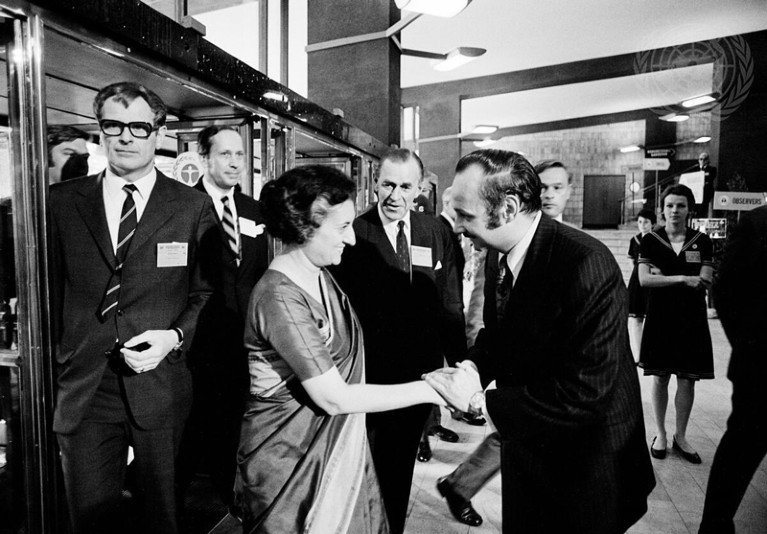
Indian prime minister Indira Gandhi meets Maurice Strong, who chaired the 1972 Stockholm Conference on the Human Environment. Gandhi saw UNEP’s potential at a time when other countries doubted its value.Credit: Yutaka Nagata/UN Photo
The United Nations Environment Programme (UNEP) will be 50 next year. But the globe’s green watchdog, which helped to create the Intergovernmental Panel on Climate Change (IPCC), very nearly didn’t exist.
During talks hosted by Sweden in 1972, low- and middle-income countries were concerned that such a body would inhibit their industrial development. Some high-income countries also questioned its creation. UK representative Solly Zuckerman, a former chief scientific adviser to prime ministers including Winston Churchill, said the science did not justify warnings that human activities could have irreversible consequences for the planet. The view in London was that, on balance, environmental pollution was for individual nations to solve — not the UN.
But the idea of UNEP had powerful supporters, too. India’s prime minister, Indira Gandhi, foresaw its potential in enabling industry to become cleaner and more humane. And the host nation made a wise choice in picking Canadian industrialist Maurice Strong to steer the often fractious talks to success. He would become UNEP’s first executive director. Two decades later, Strong re-emerged to chair the 1992 Earth Summit in Rio de Janeiro, Brazil, which created three landmark international agreements: to protect biodiversity, safeguard the climate and combat desertification.
UNEP has chalked up some impressive achievements in science and legislation. In 1988, working with the World Meteorological Organization, it co-founded the IPCC, whose scientific assessments have been pivotal to global climate action. It also responded to scientists’ warnings about the hole in the ozone layer, leading to the creation of the 1987 Montreal Protocol, an international law to phase out ozone-depleting chemicals.
Strong’s successors would go on to identify emerging green-policy issues and nudge them into the mainstream. UNEP has pushed the world of finance to think about how to stop funding polluting industries. It has also advocated working with China to green its rapid industrial growth — including the Belt and Road Initiative to develop global infrastructure. It is essential that this work continues.
UNEP also accelerated the creation of environment ministries around the world. Their ministers sit on the programme’s governing council; at their annual meeting last week, they reflected on what UNEP must do to tackle the environmental crisis. Although the environment is a rising priority for governments, businesses and civil society, progress on the UN’s flagship Sustainable Development Goals — in biodiversity, climate, land degradation, pollution, finance and more — is next to non-existent. Moreover, the degradation of nature is putting hard-won gains at risk, argues a report that UNEP commissioned as part of its half-century commemorations.
The report, Making Peace with Nature, assesses much of the same literature as would a climate- or land-degradation assessment, but its key strength is in how it brings together researchers from across environmental science. In doing so, UNEP is helping to accelerate a mode of working that should be standard. If, for example, there is to be an assessment of how climate change affects biodiversity, it makes much more sense for this to be carried out by a joint team from the IPCC and the Intergovernmental Science-Policy Platform on Biodiversity and Ecosystem Services (IPBES) than by researchers from just one of these organizations.
The UNEP report’s authors stop short of recommending such changes to the architecture of the UN’s scientific advisory bodies. That is a missed opportunity. Also missing is a discussion and recommendations on how to make countries more accountable for their environmental pledges.
Both these actions are sorely needed if the world is to take more meaningful steps to battle climate change and biodiversity loss. Countries have become expert in capturing data and reporting them to UN organizations. But there is no mechanism that holds nations to account. For example, there is no system to ensure compliance with targets for the Sustainable Development Goals.
Last week, the UN produced a report in which countries published their progress towards commitments under the 2015 Paris climate agreement, known as nationally determined contributions. The agreement includes almost 200 countries, but just 75 reported their data. There are few incentives for success and no penalties for failure. Without such measures, it is hard to see how meaningful change could ever happen.
In the past, researchers have proposed that UNEP’s member states upgrade its powers so it becomes more of a compliance body — a World Environment Organization that, like the World Trade Organization, has the power to censure countries for failing to keep to agreements. But this has been resisted as too radical a step, which would upend the autonomy of the UN biodiversity and climate organizations that UNEP itself helped to bring into being.
Twenty years ago, there might have been some justification for such a view, but now, with the world on a path to extreme climate change, any action will need to be radical, including considering how to give UNEP more teeth.
UNEP helped to lay the foundations for a scientific consensus on environmental decline, and it should be proud of the body of law that has been enacted globally. Alas, such measures risk being too little, too late. As it embarks on a year of reflection ahead of its anniversary, member states must consider what more they need to do to empower UNEP to tackle the planetary emergency.

 Chemistry can make plastics sustainable – but isn’t the whole solution
Chemistry can make plastics sustainable – but isn’t the whole solution
 UNESCO must reform to stay relevant — and reconnect people through science
UNESCO must reform to stay relevant — and reconnect people through science







